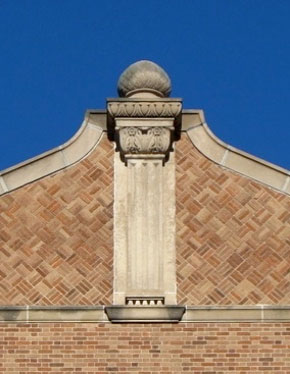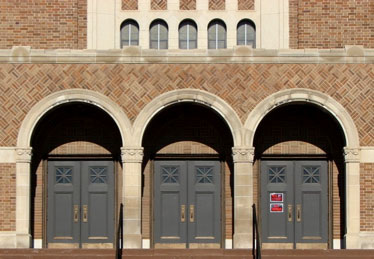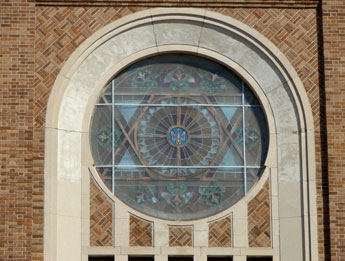59. Beth Israel Synagogue, 1925
Now Greater Galilee Missionary Baptist
2432 North Teutonia Avenue (between Meinecke Avenue and Wright Street)
Architect: Herman Bruns

Beth Israel is the successor to two Orthodox Jewish congregations that were organized in the 1880s: Anshe Jacob and Moses Montefiore. Comprised primarily of Lithuanian immigrants, the two congregations merged in 1892 and adopted the name Beth Hamedrosh Hagodol. This new congregation immediately began construction of a synagogue on 5th Street between Vliet and Cherry Streets, in what was then the center of Milwaukee’s Jewish immigrant community. However, cost overruns for construction of the synagogue led to bankruptcy and reorganization of the congregation as Beth Israel in 1901. Beth Israel occupied the synagogue on 5th Street until the early 1920s, when the congregation undertook the construction of a much larger synagogue on Teutonia Avenue, a bit more than one mile to the northwest.
The building on Teutonia Avenue is one of only two examples of the Byzantine Revival style in Milwaukee. (The other is St. Sava Serbian Orthodox Cathedral on the South Side.) There were at least two other Byzantine Revival places of worship in the city that are no longer standing: Annunciation Greek Orthodox Church on Broadway at Knapp Street (built in 1914) and Ansche Lebovich Synagogue on 11th Street at Reservoir Avenue (built in 1925). Ansche Lebovich Synagogue was quite similar in its form and details to Beth Israel, and was designed by the same architect, Herman Bruns.
The style is a revival of the religious architecture of the Byzantine Empire. Dating from the fourth century, when the emperor Constantine moved the seat of the Roman Empire to Constantinople (formerly Byzantium and now Istanbul, Turkey), the Byzantine Empire lasted into the fifteenth century. Byzantine churches typically have a prominent central dome, with smaller domes set atop polygonal drums, and often have vaulted roofs. In plan, the churches often have semi-circular extensions topped by half-domes. The Byzantine Revival style has been most often used in the United States by Eastern Orthodox churches. Some Catholic churches also adopted the style, but it was never popular with Protestant denominations. The style was popular for synagogues, partly because of its Near East origins and partly as an alternative to styles more strongly associated with Christianity, such as the Romanesque and Gothic.
The synagogue that Bruns designed for Beth Israel has offices, classrooms, and other functions on the first floor and in the raised basement. The worship space, with its high ceiling and balcony, is on the upper level. Stair towers flanking the main entrance are topped by 12-sided Byzantine domes. The walls are brick with limestone trimmings, with the bricks showing a range of tones from light tan to dark brown. An unusual feature is the extensive use of basket-weave brickwork on the façade and side walls of the stair towers, with the bricks laid diagonally. This is not a characteristic of the Byzantine Revival style, but an effort by the architect to enliven the building’s exterior.
In the years following World War II, a steady stream of the synagogue’s members moved out of the city, relocating primarily to Milwaukee’s northern suburbs. In response, Beth Israel Congregation acquired property in the suburban community of Glendale and began construction of a new synagogue in 1957. Upon completion of the new synagogue, Beth Israel sold the building on Teutonia Avenue to Greater Galilee Missionary Baptist Church. Founded in 1919, Greater Galilee is one of the city’s oldest black congregations. The church moved about 12 blocks from its former place of worship at 8th and Walnut Streets, and has now occupied the former synagogue on Teutonia Avenue for more than half a century.
Sources:
Bruns, Herman, architect. Blueprints of drawings for construction of Beth Israel Synagogue, dated March 30, 1925. Wisconsin Architectural Archive, Milwaukee Central Library, drawing set 86-2.
“Congregation Ansche Lebovich to Lay Cornerstone of New Synagogue, Sunday, April 12th,” The Wisconsin Jewish Chronicle, April 10, 1925, page 6.
Gregory, John G. History of Milwaukee, Wisconsin, volume 4. Clarke Publishing Company, 1931.
Gurda, John. One People, Many Paths: a History of Jewish Milwaukee. Jewish Museum Milwaukee, 2009.
Middleton, Roland, architect. Drawings for alterations to Greater Galilee Baptist Church, dated February 1, 1961. Wisconsin Architectural Archive, Milwaukee Central Library, drawing set 210-1.
Vollmert, Les, and Carlen Hatala. National Register of Historic Places nomination, Congregation Beth Israel Synagogue, 1991.



